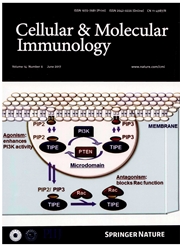

 中文摘要:
中文摘要:
氮的氧化物(没有)作为一个 immunoregulatory 分子,主要取决于 S-nitrosylation ,充当执行它的规定和信号 transduction 的一个万用的播放器因为施加它有免疫力的房间的多功能和 pleiotropy.Apoptosis 是结合的复杂进程取决于综合多样的内长、外长的信号和函数在免疫系统支撑动态平衡的积极/否定的选择。这里,不在 apoptosis 取决于它的集中的双角色被考察,在在 apoptotic 过程的一个开关模式上面繁殖。从 apoptosis 死亡的不同开关的后面的评价,开始 GSNO 的 thymocyte apoptosis 和 NOS-GSNOR 双控制的检查点(早荧光点) 的新发现是 highlighted.Moreover, S-nitrosylation/denitrosylation,作为一个氧化还原作用切换,逻辑地来临到新陈代谢本身和进一步的存取的网络整个的 neuroendicrine-immune-free 激进分子网络。而且,主人防卫调停了由不在病原体上,经由蛋白质, S-nitrosylation 也被讨论。
 英文摘要:
英文摘要:
Nitric oxide (NO) as an immunoregulatory molecule, predominantly depending on S-nitrosylation, acts as a versatile player that executes its regulation and signal transduction for exerting its multi-functions and pleiotropy. Apoptosis of immune cells is an intricate process coupled with positive/negative selection depending on integrated diverse endogenous and exogenous signals and functions to sustain homeostasis in the immune system. Here, the dual roles of NO depending on its concentration in apoptosis are reviewed, breeding up a switch mode in the apoptotic process. Following comments of different switches from apoptosis-death, a new finding of checkpoint (early fluorescence point) of GSNO-initiated thymocyte apoptosis and NOS-GSNOR double control are highlighted. Moreover, S-nitrosylation/denitrosylation, being as a redox switch, logically approaches to networks of metabolism itself and further accesses the neuroendicrine-immune-free radical network as a whole. Moreover, the host defense mediated by NO on pathogens, via protein S-nitrosylation are also discussed.
 同期刊论文项目
同期刊论文项目
 同项目期刊论文
同项目期刊论文
 Quantitative proteomic analysis of S-nitrosated proteins in diabetic mouse liver with ICAT switch me
Quantitative proteomic analysis of S-nitrosated proteins in diabetic mouse liver with ICAT switch me 期刊信息
期刊信息
